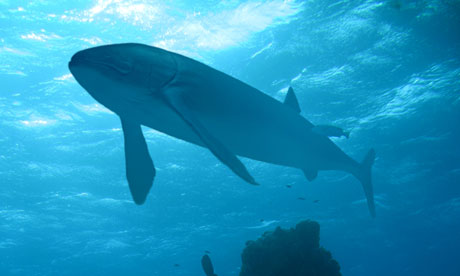Original story by Robin McKie, The Observer
A chance find in a quarry led to the discovery that Leedsichthys problematicus grew up to 50ft long – double previous estimates
An international team of scientists has uncovered the remains of the world’s largest fish. The 50ft Leedsichthys problematicus swam the oceans of the Jurassic era more than 160m years ago, sweeping up shoals of plankton through giant, mesh-covered gills. Leedsichthys was eventually wiped out by the same catastrophe that killed the dinosaurs66m years ago.
The discovery by the team – led by Professor Jeff Liston of the National Museums of Scotland – is intriguing because it reveals that just as dinosaurs on land were going through major changes which saw the appearance of animals of vast dimensions – creatures that included Diplodocus, Apatosaurus and Brachiosaurus – reptiles in the sea had also started to grow to vast proportions in the Jurassic.
“The process is known as gigantism,” said Liston. “It was known about in land animals at the time but we had no way of knowing if a parallel process occurred in the oceans. We now know that it did – though the reason for appearance of these gigantic beasts, both on land and in the water, is not clear at present.”
Pieces of Leedsichthys fossils were first found by the British collector Alfred Leeds in 1889. Similar remains were subsequently found at other sites, from northern Germany to Normandy, Mexico and the Atacama desert in Chile. However, knowledge of the fish remained sketchy because of the poor quality of these finds. Leedsichthys had a skeleton that was mostly made of cartilage and which does not fossilise easily. This paucity of evidence and lack of clarity about its dimensions led to the fish being given its second name: problematicus.
Based on the best evidence they could muster, scientists calculated thatLeedsichthys could have grown to be more than 25ft long. A chance discovery in a quarry outside Whittlesea near Peterborough several years ago changed that. “Two students were working on a geology project in the quarry when they noticed pieces of bone sticking out of the rocks,” said Liston, who is scheduled to present details of his team’s discovery at the Symposium on Vertebrate Palaeontology and Comparative Anatomy in Edinburgh this week. “It turned out to be fossil pieces of Leedsichthys – a real breakthrough.”
Liston and colleagues unearthed an almost complete skeleton ofLeedsichthys at the quarry. Working with Mike Newbrey of the Royal Tyrrell Museum in Alberta, Professor Colin Adams of Glasgow University, and Dr Tom Challands of Edinburgh University, Liston was able to show that the specimen had grown to around 50ft long, twice previous estimates. It was also discovered that the giant fish had a delicate mesh over its gills which acted like a trawler’s net by catching plankton as seawater passed through its mouth.
“From its size alone, Leedsichthys must have been a charismatic animal,” said Adams. “However, equally fascinating for scientists are the ecological processes that enable such a large aquatic animal to thrive.”
This point was backed by Liston. “Before this period, vertebrate suspension-feeders like these did not get larger than 50cm in length. Something important must have changed – probably in plankton populations. Understanding the nature of these changes has important implications for our understanding of biological productivity in modern oceans, and how that productivity has changed over time.”

Sorry, the comment form is closed at this time.